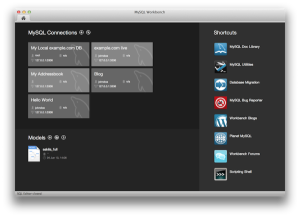 Oracle has revamped the user interface for its MySQL Workbench administration software, streamlining a number of routine operations and adding some new time-saving features as well.
Oracle has revamped the user interface for its MySQL Workbench administration software, streamlining a number of routine operations and adding some new time-saving features as well.
“The enhanced design in the multi-platform GUI not only increases usability and productivity of the tool, but also offers new database management capabilities,” wrote Oracle senior product manager Mike Frank, in a blog post announcing the new release.
Overall, Oracle made over 200 changes to the community edition to the software, based on user feedback, according to the company.
Run by itself, Oracle’s open-source MySQL database management system can only be operated from the command line, so MySQL Workbench, which is a separate application, provides a GUI administration interface that provides point-and-click operations to many MySQL administration tasks, as well as visual tools for SQL development and data modeling.
Prior to this release, the Workbench offered a boxy and occasionally clunky user interface, so the updated look and feel brings it more into line with other more modern programs. The developers also took this opportunity to add in some new features.
Managing schemas gets easier in a number of ways, thanks to the update. A new schema inspector provides details of all the objects in a schema, and provides access to maintenance operations such as analyze and optimize table. It can now also synchronize entity-relationship models with live schemas.
The software can now display the results of queries as column/value pair lists, which promises to better display those queries that result in many columns, but comparatively few rows.
It can reduce the work on some routine operations, such as cascading delete commands for rows referenced by foreign keys, which minimizes the tedious chore of executing a number of delete commands individually.
A new table data search function provides a way to search for text across multiple tables and schemas.
On the administration side, MySQL Workbench now provides a summary of a the operational status and configuration of a server running MySQL. It also provides a way to migrate databases from other database management systems, specifically from Microsoft SQL Server, Sybase Adaptive Server Enterprise and PostgreSQL. Additional support has also been added for Sybase SQL Anywhere and SQLite.
The community edition of MySQL Workbench is available free of charge under the open source GPL (GNU General Public License) license. The commercial edition of the product is included in the MySQL Enterprise Edition subscription.
The updated enterprise edition comes with a number of exclusive new features. The backup utility now can set up, schedule and run backups, as well as view their progress as they run. Also, restoration of data can now be automated. The new enterprise edition also comes with an audit log inspector to browse, filter, search and analyze audit MySQL log data.
Oracle has prepared MySQL Workbench to work on computers running Microsoft Windows, Mac OS X (versions 10.6+ and newer), Red Hat Enterprise Linux 6, Oracle Linux 6, Fedora 18, Ubuntu 12.04 and Ubuntu 13.04





